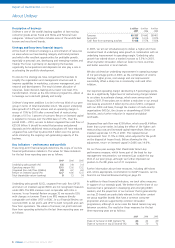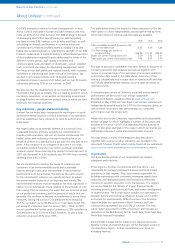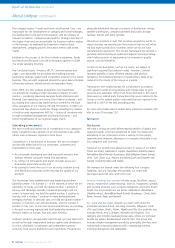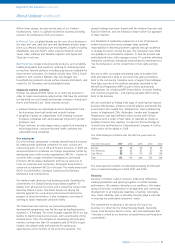Unilever 2007 Annual Report Download - page 18
Download and view the complete annual report
Please find page 18 of the 2007 Unilever annual report below. You can navigate through the pages in the report by either clicking on the pages listed below, or by using the keyword search tool below to find specific information within the annual report.
16 Unilever Annual Report and Accounts 2007
Report of the Directors continued
Europe (continued)
2006 compared with 2005
€ million € million
2006 2005
Turnover 15 000 14 940
Operating profit 1 903 2 064
Operating margin 12.7% 13.8%
Restructuring, business disposals, impairment charges
and one-time gain (2006) on UK pension
plans included in operating margin (1.4)% (0.9)%
%
Underlying sales growth at constant rates 1.0
Effect of acquisitions 0.1
Effect of disposals (0.9)
Effect of exchange rates 0.2
Turnover growth at current rates 0.4
%
Operating profit 2006 vs 2005
Change at current rates (7.7)
Change at constant rates (7.9)
Turnover at current rates of exchange rose by 0.4%, after the
impact of acquisitions, disposals and exchange rate changes as
set out in the table above. Operating profit at current rates of
exchange fell by 7.7%, after including a favourable currency
movement of 0.2%. The underlying performance of the business
after eliminating these exchange translation effects and the
impact of acquisitions and disposals is discussed below at
constant exchange rates.
The UK, our largest European business, returned to growth in
the year with good results across several foods and personal care
ranges. Although laundry sales declined, there were promising
signs of progress in market share with Persil regaining its position
as the country’s leading laundry brand. The Netherlands had a
strong year. A pioneer of One Unilever, it benefited from
operating as a single company. Highlights were rapid growth for
Lipton, Dove, Rexona and Axe. France remained a difficult market
with sales lower in spreads, laundry and hair care. New
management was put in place and there was an improvement in
the second half of the year. Sales in Germany held up better in
2006. There was good growth for personal care brands but some
turnover in Lipton ice tea was lost following changes in rules for
bottle returns. Central and Eastern Europe continued to do well,
driven by double-digit growth in Russia.
The sale of the majority of our European frozen foods businesses
to Permira was successfully completed during the year.
Our 2006 innovation programmes resulted in our Foods brands
wholeheartedly embracing the concept of Vitality, with new
products designed to deliver the health benefits that consumers
seek. Rama/Blue Band Idea! – spreads with added nutrients which
are beneficial to children’s mental development – was launched in
2006.
Operating Review – Regions continued
A range of Knorr bouillon cubes with selected natural ingredients
and a better, richer taste was rolled out across the region, while
Knorr Vie one-shot fruit and vegetable products became available
in 12 countries. Meanwhile, Latin America’s AdeS drink, a healthy
blend of fruit juices and soya, was launched successfully in the UK
as AdeZ.
Product launches with clear functional or emotional benefits in
Home and Personal Care brands were rolled out rapidly across the
region. A range of new Dove launches included the moisturising
self-tan Dove Summer Glow. Meanwhile in household care, we
introduced Domestos 5x which continues to kill germs even after
several flushes and the cleaning power of Cif was applied to a
series of power sprays.
The operating margin, at 12.7%, was 1.1 percentage points
lower than in 2005, with higher net costs for restructuring,
disposals and impairments, partially offset by a one-time gain of
€120 million from changes to the UK pensions plan. Before these
items, the operating margin would have been 0.6 percentage
points lower than in 2005. Margins in Foods were lower than in
2005 as we absorbed significant increases in commodity costs
which were only partly compensated by savings programmes.
The Americas
2007 compared with 2006
€ million € million
2007 2006
Turnover 13 442 13 779
Operating profit 1 971 2 178
Operating margin 14.7% 15.8%
Restructuring, business disposals, impairment charges
and one-time gain (2006) on US healthcare
plans included in operating margin (0.7)% 0.0%
%
Underlying sales growth at constant rates 4.1
Effect of acquisitions 0.1
Effect of disposals (0.6)
Effect of exchange rates (5.8)
Turnover growth at current rates (2.4)
%
Operating profit 2007 vs 2006
Change at current rates (9.5)
Change at constant rates (3.4)
Turnover at current rates of exchange fell by 2.4%, after the
impact of acquisitions, disposals and exchange rate changes as set
out in the table above. Operating profit at current rates of
exchange fell by 9.5%, after including an adverse currency
movement of 6.1%. The underlying performance of the business
after eliminating these exchange translation effects and the
impact of acquisitions and disposals is discussed below at
constant exchange rates.
























